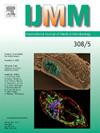Comparative genomics of clinical hybrid Escherichia coli strains in Norway
IF 3.6
3区 医学
Q1 MICROBIOLOGY
引用次数: 0
Abstract
The global rise of hybrid Escherichia coli (E. coli) is a major public health concern, as enhanced virulence from multiple pathotypes complicates the traditional E. coli classification system and challenges clinical diagnostics. Hybrid strains are particularly concerning as they can infect both intestinal and extraintestinal sites, complicating treatment and increasing the risk of severe disease. This study analyzed virulence-associated genes (VAGs) in 13 E. coli isolates from fecal samples of patients with symptoms of gastrointestinal (GI) infection in Norwegian hospitals and clinics. Whole genome sequencing (WGS) was conducted using Oxford Nanopore’s MinION and Illumina’s MiSeq platforms. Eleven strains harbored molecular diagnostic markers of atypical enteropathogenic E. coli (aEPEC), enteroinvasive E. coli (EIEC), Shiga toxin-producing E. coli (STEC), enterotoxigenic E. coli (ETEC), or typical enteropathogenic E. coli (tEPEC). Two of those isolates were identified as triple intestinal hybrids with molecular diagnostic markers for aEPEC, EIEC, and STEC. Notably, two isolates lacked any IPEC-specific molecular diagnostic markers, yet were suspected of causing the patient’s GI infection. Furthermore, genes associated with extraintestinal pathogenic E. coli (ExPEC)—including adhesins, toxins, protectins, siderophores, iron acquisition systems, and invasins—were identified in all the isolates. Thus, most of the isolates were classified as hybrid aEPEC/ExPEC, STEC/ExPEC, tEPEC/ExPEC, or aEPEC/EIEC/STEC/ExPEC. These findings emphasize the genomic plasticity of E. coli and highlight the need to revise the classification system for enteric pathogens.
挪威临床杂交大肠杆菌菌株的比较基因组学研究
杂交大肠杆菌(E. coli)在全球范围内的兴起是一个重大的公共卫生问题,因为多种病原菌的毒力增强使传统的大肠杆菌分类系统复杂化,并对临床诊断提出挑战。杂交菌株尤其令人担忧,因为它们可以感染肠道和肠外部位,使治疗复杂化并增加严重疾病的风险。本研究分析了挪威医院和诊所中有胃肠道(GI)感染症状的患者粪便样本中分离的13株大肠杆菌的毒力相关基因(VAGs)。全基因组测序(WGS)使用Oxford Nanopore的MinION和Illumina的MiSeq平台进行。11株菌株含有非典型肠致病性大肠杆菌(aEPEC)、肠侵袭性大肠杆菌(EIEC)、产志贺毒素大肠杆菌(STEC)、产肠毒素大肠杆菌(ETEC)或典型肠致病性大肠杆菌(tEPEC)的分子诊断标记。其中两株被鉴定为具有aEPEC、EIEC和STEC分子诊断标记的三重肠道杂交株。值得注意的是,两个分离株缺乏任何ipec特异性分子诊断标记,但怀疑引起患者的胃肠道感染。此外,在所有分离株中均鉴定出与肠外致病性大肠杆菌(ExPEC)相关的基因,包括粘附素、毒素、保护蛋白、铁载体、铁获取系统和侵入性。因此,大多数分离株被分类为aEPEC/ exp、STEC/ exp、tEPEC/ exp或aEPEC/EIEC/STEC/ exp。这些发现强调了大肠杆菌的基因组可塑性,并强调了修改肠道病原体分类系统的必要性。
本文章由计算机程序翻译,如有差异,请以英文原文为准。
求助全文
约1分钟内获得全文
求助全文
来源期刊
CiteScore
9.70
自引率
0.00%
发文量
18
审稿时长
45 days
期刊介绍:
Pathogen genome sequencing projects have provided a wealth of data that need to be set in context to pathogenicity and the outcome of infections. In addition, the interplay between a pathogen and its host cell has become increasingly important to understand and interfere with diseases caused by microbial pathogens. IJMM meets these needs by focussing on genome and proteome analyses, studies dealing with the molecular mechanisms of pathogenicity and the evolution of pathogenic agents, the interactions between pathogens and host cells ("cellular microbiology"), and molecular epidemiology. To help the reader keeping up with the rapidly evolving new findings in the field of medical microbiology, IJMM publishes original articles, case studies and topical, state-of-the-art mini-reviews in a well balanced fashion. All articles are strictly peer-reviewed. Important topics are reinforced by 2 special issues per year dedicated to a particular theme. Finally, at irregular intervals, current opinions on recent or future developments in medical microbiology are presented in an editorial section.

 求助内容:
求助内容: 应助结果提醒方式:
应助结果提醒方式:


